#granville t woods
Text
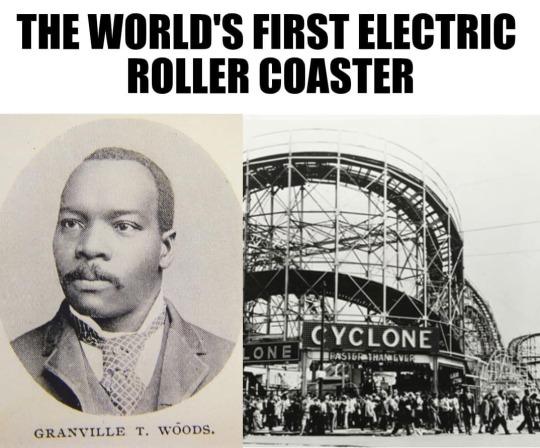
THE WORLD'S FIRST ELECTRIC ROLLER COASTER
Granville T. Woods (April 23, 1856 – January 30, 1910) introduced the “Figure Eight,” the world's first electric roller coaster, in 1892 at Coney Island Amusement Park in New York. Woods patented the invention in 1893, and in 1901, he sold it to General Electric.
Woods was an American inventor who held more than 50 patents in the United States. He was the first African American mechanical and electrical engineer after the Civil War. Self-taught, he concentrated most of his work on trains and streetcars.
In 1884, Woods received his first patent, for a steam boiler furnace, and in 1885, Woods patented an apparatus that was a combination of a telephone and a telegraph. The device, which he called "telegraphony", would allow a telegraph station to send voice and telegraph messages through Morse code over a single wire. He sold the rights to this device to the American Bell Telephone Company.
In 1887, he patented the Synchronous Multiplex Railway Telegraph, which allowed communications between train stations from moving trains by creating a magnetic field around a coiled wire under the train. Woods caught smallpox prior to patenting the technology, and Lucius Phelps patented it in 1884. In 1887, Woods used notes, sketches, and a working model of the invention to secure the patent. The invention was so successful that Woods began the Woods Electric Company in Cincinnati, Ohio, to market and sell his patents. However, the company quickly became devoted to invention creation until it was dissolved in 1893.
Woods often had difficulties in enjoying his success as other inventors made claims to his devices. Thomas Edison later filed a claim to the ownership of this patent, stating that he had first created a similar telegraph and that he was entitled to the patent for the device. Woods was twice successful in defending himself, proving that there were no other devices upon which he could have depended or relied upon to make his device. After Thomas Edison's second defeat, he decided to offer Granville Woods a position with the Edison Company, but Woods declined.
In 1888, Woods manufactured a system of overhead electric conducting lines for railroads modeled after the system pioneered by Charles van Depoele, a famed inventor who had by then installed his electric railway system in thirteen United States cities.
Following the Great Blizzard of 1888, New York City Mayor Hugh J. Grant declared that all wires, many of which powered the above-ground rail system, had to be removed and buried, emphasizing the need for an underground system. Woods's patent built upon previous third rail systems, which were used for light rails, and increased the power for use on underground trains. His system relied on wire brushes to make connections with metallic terminal heads without exposing wires by installing electrical contactor rails. Once the train car had passed over, the wires were no longer live, reducing the risk of injury. It was successfully tested in February 1892 in Coney Island on the Figure Eight Roller Coaster.
In 1896, Woods created a system for controlling electrical lights in theaters, known as the "safety dimmer", which was economical, safe, and efficient, saving 40% of electricity use.
Woods is also sometimes credited with the invention of the air brake for trains in 1904; however, George Westinghouse patented the air brake almost 40 years prior, making Woods's contribution an improvement to the invention.
Woods died of a cerebral hemorrhage at Harlem Hospital in New York City on January 30, 1910, having sold a number of his devices to such companies as Westinghouse, General Electric, and American Engineering. Until 1975, his resting place was an unmarked grave, but historian M.A. Harris helped raise funds, persuading several of the corporations that used Woods's inventions to donate money to purchase a headstone. It was erected at St. Michael's Cemetery in Elmhurst, Queens.
LEGACY
▪Baltimore City Community College established the Granville T. Woods scholarship in memory of the inventor.
▪In 2004, the New York City Transit Authority organized an exhibition on Woods that utilized bus and train depots and an issue of four million MetroCards commemorating the inventor's achievements in pioneering the third rail.
▪In 2006, Woods was inducted into the National Inventors Hall of Fame.
▪In April 2008, the corner of Stillwell and Mermaid Avenues in Coney Island was named Granville T. Woods Way.
473 notes
·
View notes
Text

THE WORLD'S FIRST ELECTRIC ROLLER COASTER
Granville T. Woods (April 23, 1856 – January 30, 1910) introduced the “Figure Eight,” the world's first electric roller coaster, in 1892 at Coney Island Amusement Park in New York. Woods patented the invention in 1893, and in 1901, he sold it to General Electric.
Woods was an American inventor who held more than 50 patents in the United States. He was the first African American mechanical and electrical engineer after the Civil War. Self-taught, he concentrated most of his work on trains and streetcars.
In 1884, Woods received his first patent, for a steam boiler furnace, and in 1885, Woods patented an apparatus that was a combination of a telephone and a telegraph. The device, which he called "telegraphony", would allow a telegraph station to send voice and telegraph messages through Morse code over a single wire. He sold the rights to this device to the American Bell Telephone Company.
In 1887, he patented the Synchronous Multiplex Railway Telegraph, which allowed communications between train stations from moving trains by creating a magnetic field around a coiled wire under the train. Woods caught smallpox prior to patenting the technology, and Lucius Phelps patented it in 1884. In 1887, Woods used notes, sketches, and a working model of the invention to secure the patent. The invention was so successful that Woods began the Woods Electric Company in Cincinnati, Ohio, to market and sell his patents. However, the company quickly became devoted to invention creation until it was dissolved in 1893.
Woods often had difficulties in enjoying his success as other inventors made claims to his devices. Thomas Edison later filed a claim to the ownership of this patent, stating that he had first created a similar telegraph and that he was entitled to the patent for the device. Woods was twice successful in defending himself, proving that there were no other devices upon which he could have depended or relied upon to make his device. After Thomas Edison's second defeat, he decided to offer Granville Woods a position with the Edison Company, but Woods declined.
In 1888, Woods manufactured a system of overhead electric conducting lines for railroads modeled after the system pioneered by Charles van Depoele, a famed inventor who had by then installed his electric railway system in thirteen United States cities.
Following the Great Blizzard of 1888, New York City Mayor Hugh J. Grant declared that all wires, many of which powered the above-ground rail system, had to be removed and buried, emphasizing the need for an underground system. Woods's patent built upon previous third rail systems, which were used for light rails, and increased the power for use on underground trains. His system relied on wire brushes to make connections with metallic terminal heads without exposing wires by installing electrical contactor rails. Once the train car had passed over, the wires were no longer live, reducing the risk of injury. It was successfully tested in February 1892 in Coney Island on the Figure Eight Roller Coaster.
In 1896, Woods created a system for controlling electrical lights in theaters, known as the "safety dimmer", which was economical, safe, and efficient, saving 40% of electricity use.
Woods is also sometimes credited with the invention of the air brake for trains in 1904; however, George Westinghouse patented the air brake almost 40 years prior, making Woods's contribution an improvement to the invention.
Woods died of a cerebral hemorrhage at Harlem Hospital in New York City on January 30, 1910, having sold a number of his devices to such companies as Westinghouse, General Electric, and American Engineering. Until 1975, his resting place was an unmarked grave, but historian M.A. Harris helped raise funds, persuading several of the corporations that used Woods's inventions to donate money to purchase a headstone. It was erected at St. Michael's Cemetery in Elmhurst, Queens.
LEGACY
▪Baltimore City Community College established the Granville T. Woods scholarship in memory of the inventor.
▪In 2004, the New York City Transit Authority organized an exhibition on Woods that utilized bus and train depots and an issue of four million MetroCards commemorating the inventor's achievements in pioneering the third rail.
▪In 2006, Woods was inducted into the National Inventors Hall of Fame.
▪In April 2008, the corner of Stillwell and Mermaid Avenues in Coney Island was named Granville T. Woods Way.
#granville t woods#black inventor#invented#world's first#electric roller coaster#1893#read about him#read about his invention#reading is fundamental#knowledge is power#black history
123 notes
·
View notes
Text

10 notes
·
View notes
Text
#talkin#tik tok#food#recipes#super soaker#lonnie johnson#beer tap#richard spikes#roller coaster#nikki.mov#granville t. woods
134 notes
·
View notes
Text

Granville T. Woods
Biography
(1856–1910)
Known as "African Edison," Granville Woods was an African American inventor who made key contributions to the development of the telephone, streetcar and more.
Who Was Granville T. Woods?
Granville T. Woods, born to free African Americans, held various engineering and industrial jobs before establishing a company to develop electrical apparatus. Known as "African Edison," he registered nearly 60 patents in his lifetime, including a telephone transmitter, a trolley wheel and the multiplex telegraph (over which he defeated a lawsuit by Thomas Edison).
Early Life
Born in Columbus, Ohio, on April 23, 1856, Woods received little schooling as a young man and, in his early teens, took up a variety of jobs, including as a railroad engineer in a railroad machine shop, as an engineer on a British ship, in a steel mill, and as a railroad worker. From 1876 to 1878, Woods lived in New York City, taking courses in engineering and electricity — a subject that he realized, early on, held the key to the future.
Back in Ohio in the summer of 1878, Woods was employed for eight months by the Springfield, Jackson and Pomeroy Railroad Company to work at the pumping stations and the shifting of cars in the city of Washington Court House, Ohio. He was then employed by the Dayton and Southeastern Railway Company as an engineer for 13 months.
During this period, while traveling between Washington Court House and Dayton, Woods began to form ideas for what would later be credited as his most important invention: the "inductor telegraph." He worked in the area until the spring of 1880 and then moved to Cincinnati.
Early Inventing Career
Living in Cincinnati, Woods eventually set up his own company to develop, manufacture and sell electrical apparatus, and in 1889, he filed his first patent for an improved steam boiler furnace. His later patents were mainly for electrical devices, including his second invention, an improved telephone transmitter.

#granvile t woods#african#kemetic dreams#edison#cincinnati#telephone#railroad#railway#railroads#african american
80 notes
·
View notes
Text
Granville T. Woods, the ‘Black Edison,’ electrified subway travel with his groundbreaking third-rail system, a cornerstone of today’s transit safety. #blackhistorymonth #GranvilleWoods #bhm
24 notes
·
View notes
Text
Visit the original article to click through to the entire list - PASS IT ON
Lesson 1: Kemet
Ancient Egyptians called their land "Kemet"--or Black Land. The first person to practice medicine was from Kemet, along with the first dentist! 29 Black History Facts You Probably Didn't Learn at School: Lesson 1 01:10
Lesson 2: Shotgun homes and front porches
The shotgun home and front porch design originated in West Africa in what is now Nigeria. 29 Black History Facts You Probably Didn't Learn at School: Lesson 2 01:07
Lesson 3: Walls of Benin
The Walls of Benin were four times longer than the Great Wall of China. So, what happened to them? 29 Black History Facts You Probably Didn't Learn at School: Lesson 3 01:10
Lesson 4: University of Sankore
One of the first universities in the world was located in Mali. 29 Black History Facts You Probably Didn't Learn at School: Lesson 4 01:07
Lesson 5: 1526
The year 1619 is known as the year that Blacks were first enslaved in America. What about the year 1526? 29 Black History Facts You Probably Didn't Learn at School: Lesson 5 01:10
Lesson 6: Freedom by any means
How braided hair, Gospel music, and drums played a role in the liberation of Blacks. 29 Black History Facts You Probably Didn't Learn at School: Lesson 6 01:06
Lesson 7: Benjamin Banneker
Meet the man who helped design Washington, D.C., and that's not all. 29 Black History Facts You Probably Didn't Learn at School: Lesson 7 01:07
Lesson 8: Queen Nanny of the Maroons
She was like Harriet Tubman, but she freed slaves someplace else. 29 Black History Facts You Probably Didn't Learn at School: Lesson 8 01:05
Lesson 9: Henry "Box" Brown
Learn more about how Henry Brown got his nickname. It's incredible. 29 Black History Facts You Probably Didn't Learn at School: Lesson 9 01:10
Lesson 10: Henrietta Bowers
Learn how this undertaker used her background to free Black slaves. 29 Black History Facts You Probably Didn't Learn at School: Lesson 10 01:06
Lesson 11: John Berry Meachum
Learn more about the "Floating Freedom School" and why Meachum had to put it on a boat. 29 Black History Facts You Probably Didn't Learn at School: Lesson 11 01:04
Lesson 12: Lewis Latimer
How Louis Latimer made one of Thomas Edison's famous inventions better. 29 Black History Facts You Probably Didn't Learn at School: Lesson 12 01:00
Lesson 13: Granville T. Woods
How modern wireless technology can be traced back to Granville Woods in the 1800s. 29 Black History Facts You Probably Didn't Learn at School: Lesson 13 01:06
Lesson 14: Oscar Micheaux
The man who paved the way for today's great Black filmmakers. 29 Black History Facts You Probably Didn't Learn at School: Lesson 14 01:02
Lesson 15: Marie Van Brittan Brown
Those Ring cameras are everywhere. It basically started with Marie Van Brittan Brown's invention in the 1960s. 29 Black History Facts You Probably Didn't Learn at School: Lesson 15 01:02
18 notes
·
View notes
Text
Black inventors

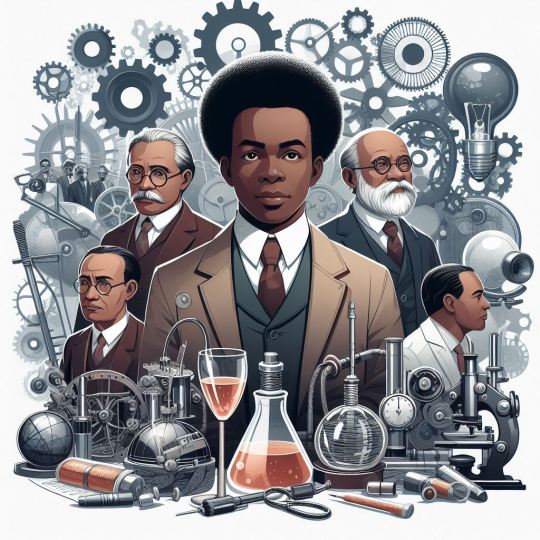
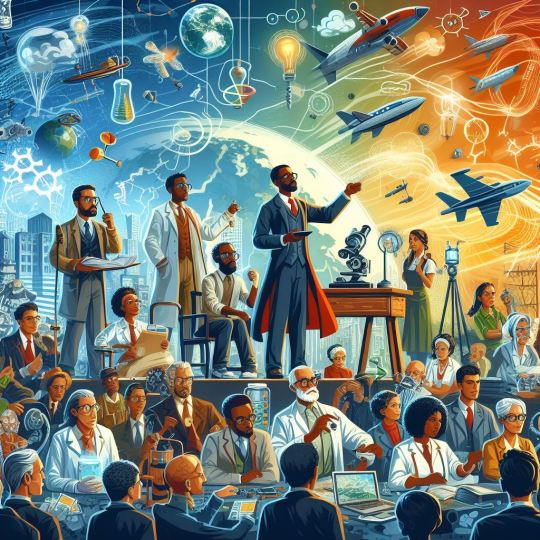
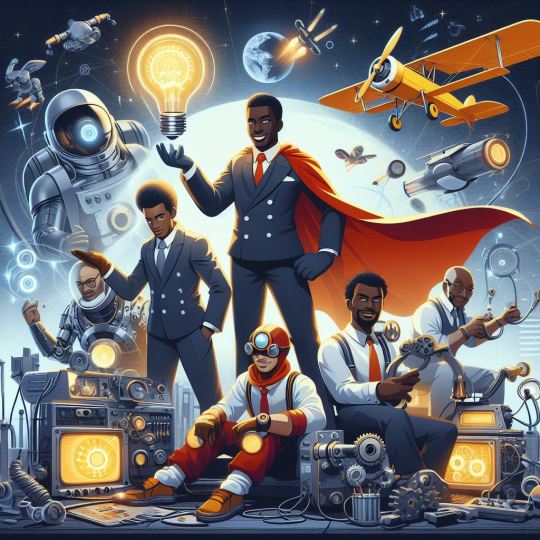
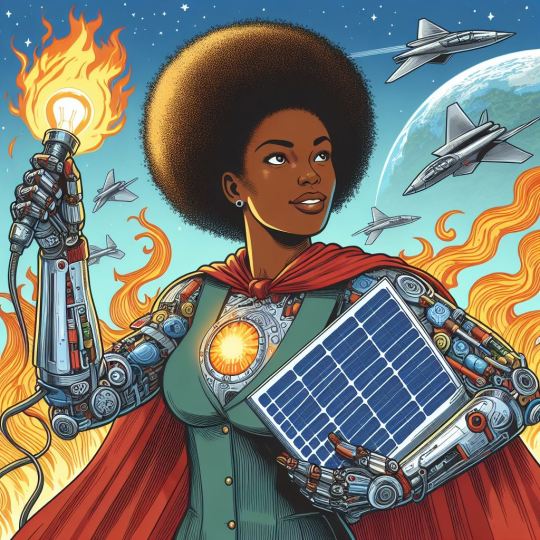


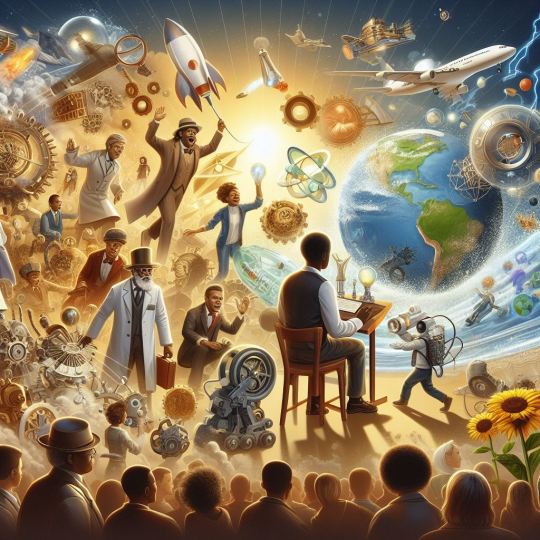
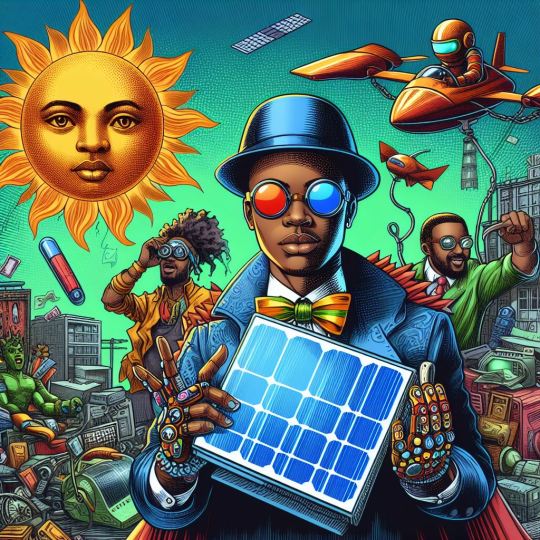
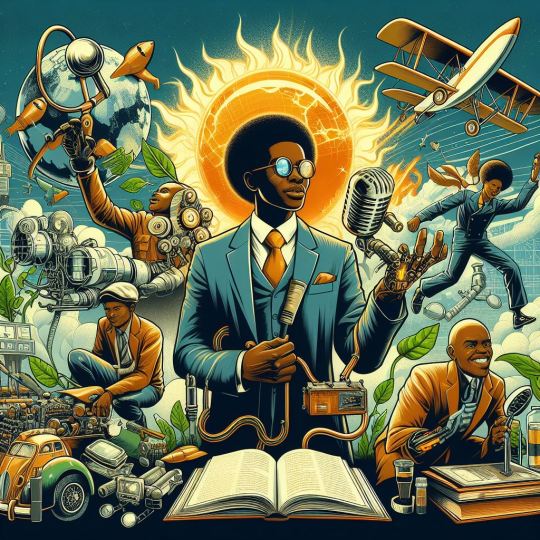

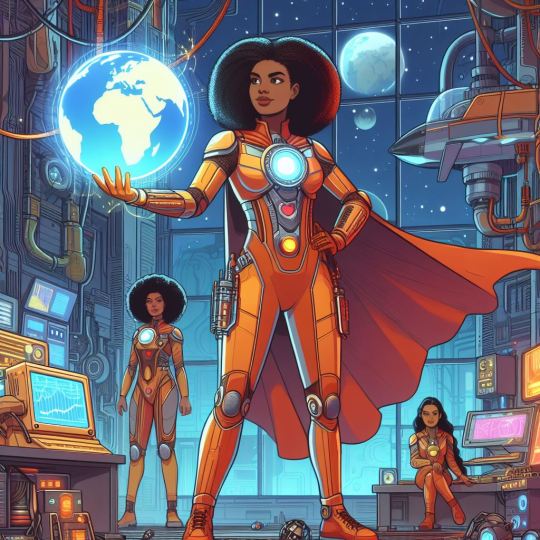
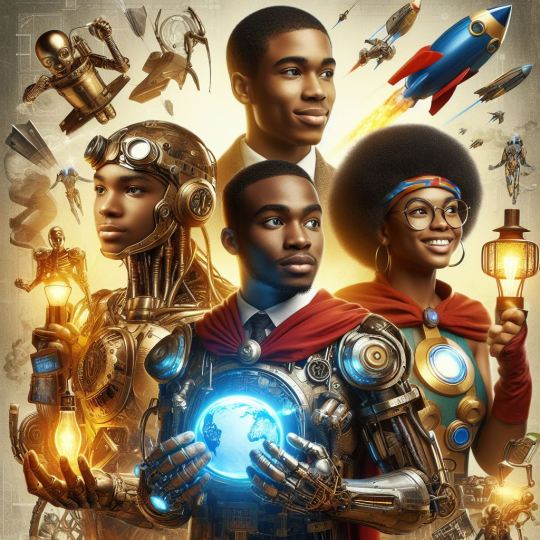
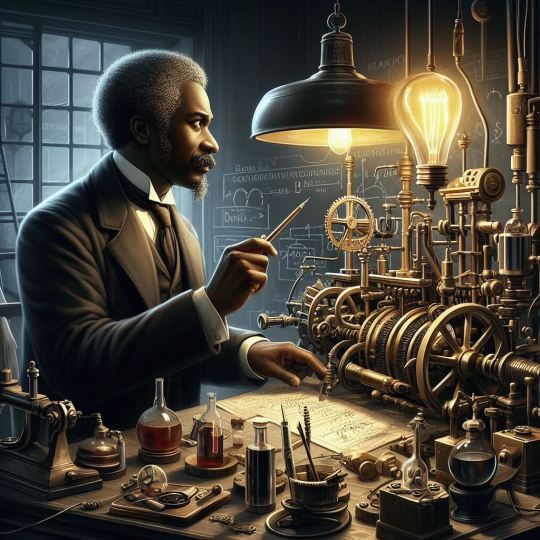
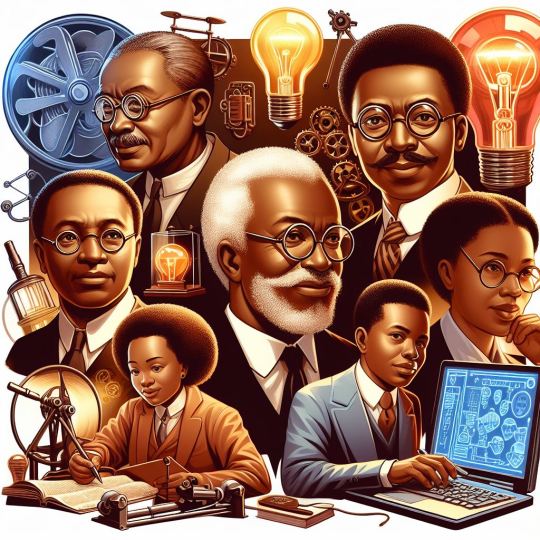
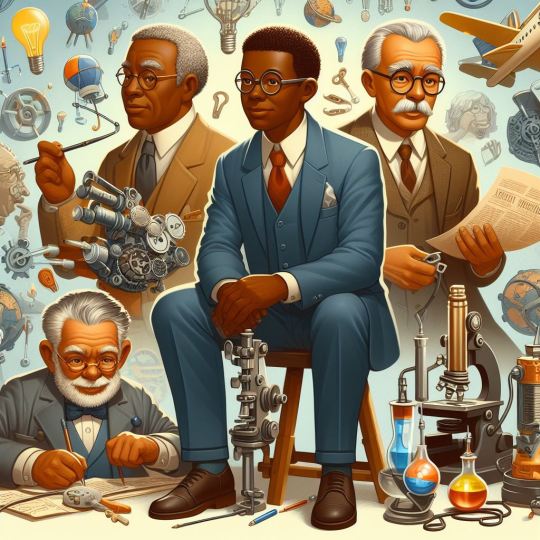
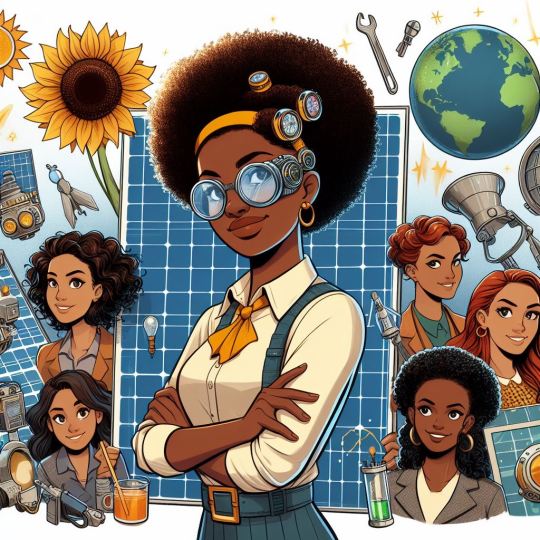
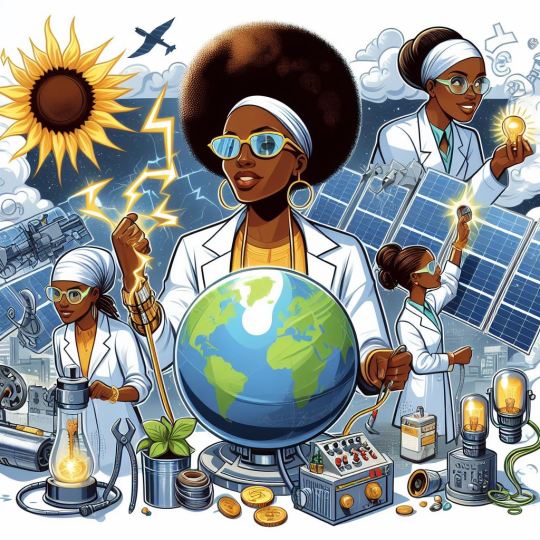
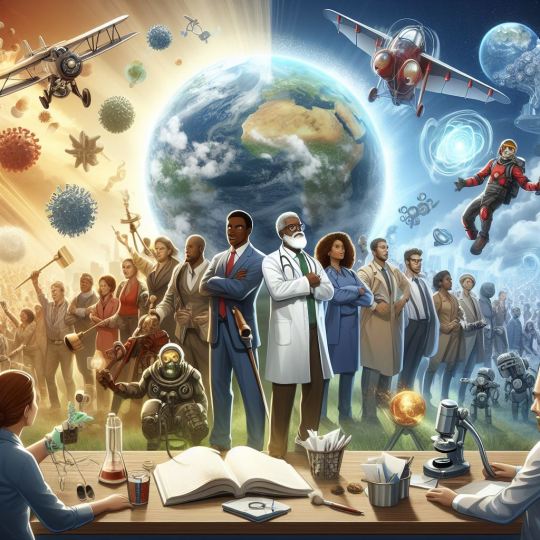
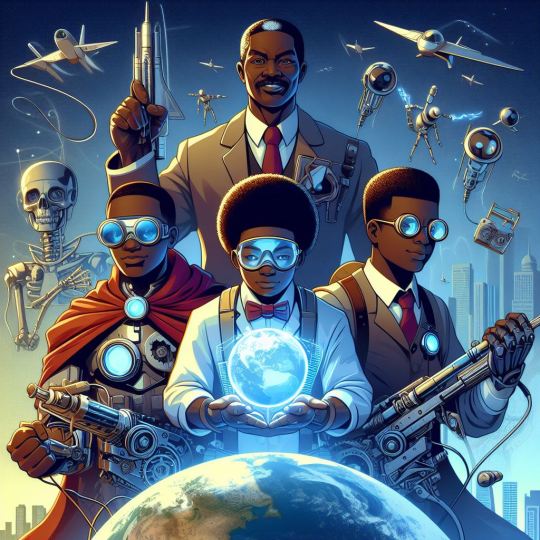

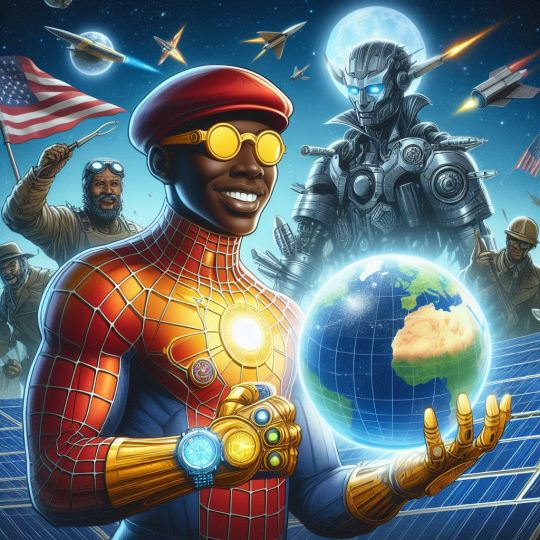
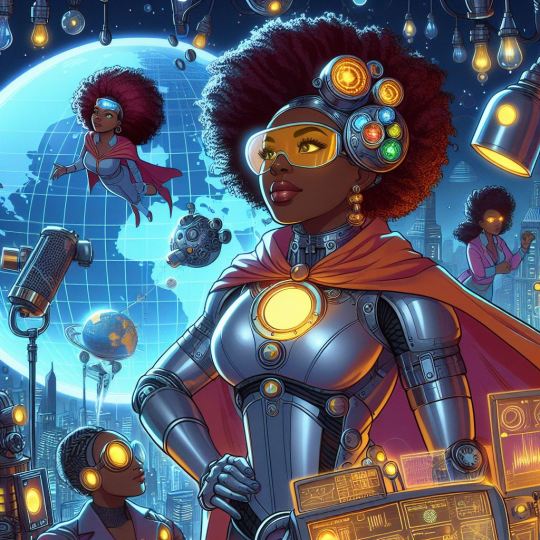
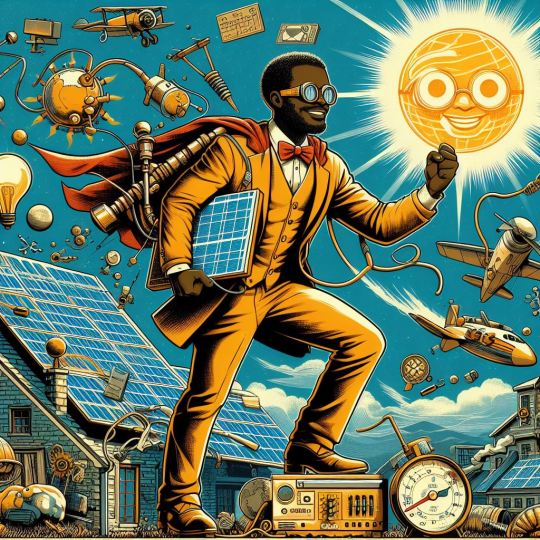
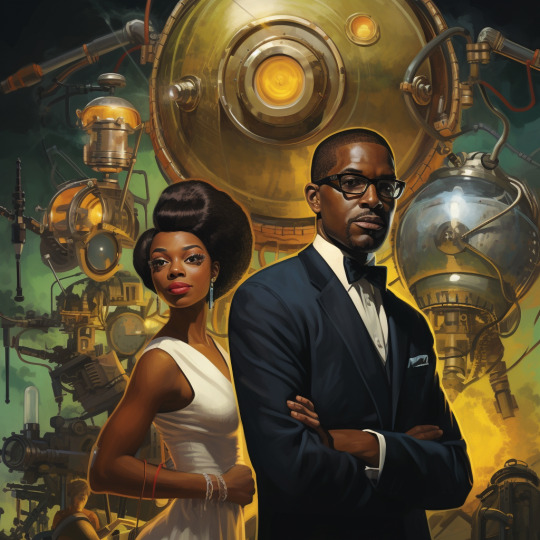

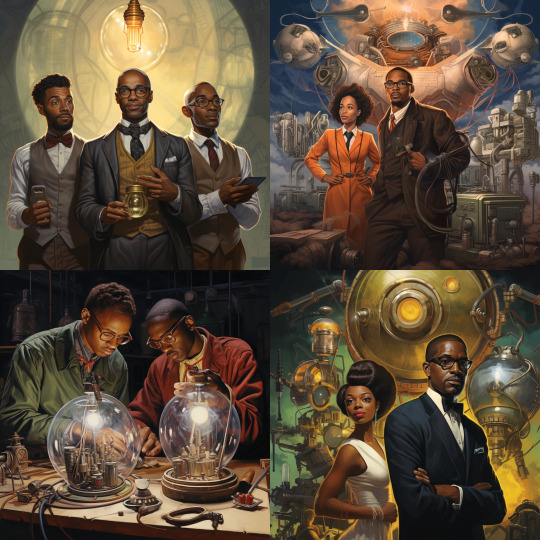
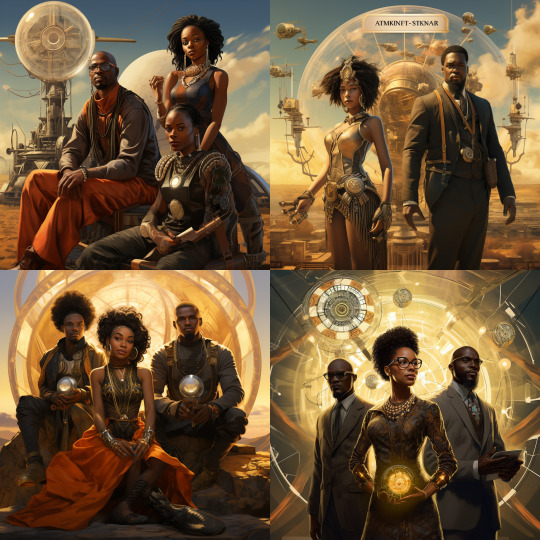

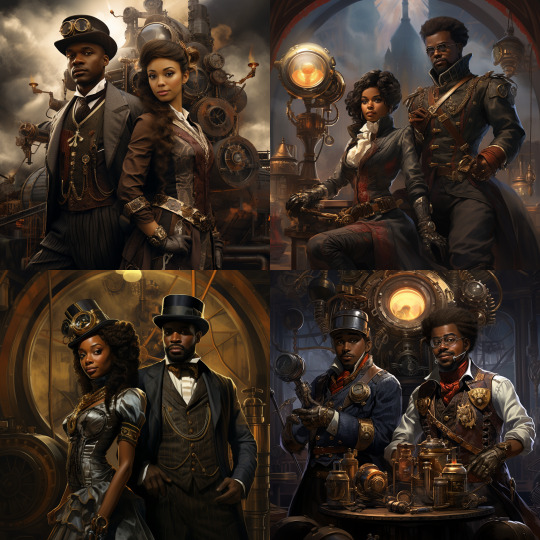
From Perplexity:
Famous black inventors have significantly contributed to various fields, from everyday household items to groundbreaking technological advancements. Here are some notable figures:
George Crum (1824-1914): A chef who is credited with inventing the potato chip in 1853[1].
Frederick McKinley Jones (1893-1961): Developed refrigeration equipment for trucks, trains, ships, and planes, receiving over 40 patents. His invention, the Thermo King, revolutionized the food and medical transport industries[1].
Granville T. Woods (1856-1910): Accumulated almost 60 patents, improving railroad functioning. Notably, he invented the induction telegraph system for train communication[1].
George Washington Carver (1864-1943): An agricultural chemist who developed 518 products from peanuts and sweet potatoes, including ink, dye, soap, and synthetic rubber[1].
Madam C.J. Walker (1867-1919): Became the first African American woman self-made millionaire by creating a line of hair products for African American women[1].
Garrett Morgan (1877-1963): Invented the traffic signal and a safety hood that served as a prototype for the gas mask[1].
Mary Beatrice Davidson Kenner: Patented the sanitary belt in 1957, a significant advancement in women's health and hygiene[1].
Thomas L. Jennings (1791–1859): The first African American to receive a U.S. patent, for a dry-cleaning process[4].
Patricia Bath (1942-2019): Invented a laser cataract treatment, becoming the first African American female doctor to receive a medical patent[4].
Mark Dean (1957-present): Holds over 20 patents, including contributions to the creation of the color PC monitor and the first gigahertz chip[4].
Elijah McCoy (1844-1929): Known for his invention of the automatic lubricator for oiling steam engines, leading to the phrase "the real McCoy" to denote something authentic[4].
These inventors have left a lasting impact on society, demonstrating ingenuity and perseverance in the face of challenges.
Citations:
[1] https://www.oprahdaily.com/life/work-money/g30877473/african-american-inventors/
[2] https://www.parents.com/kids/education/world-changing-black-inventors-that-every-kid-should-know-about/
[3] https://www.black-inventor.com
[4] https://www.biography.com/inventors/g46697619/famous-black-inventors
[5] https://en.wikipedia.org/wiki/List_of_African-American_inventors_and_scientists
From Gemini (formerly Bard):
20 Famous Black Investors with Short Descriptions:
Dr. Shirley Jackson: First Black woman to earn a doctorate in nuclear physics, invested in research and development for the U.S. Department of Defense.
Robert F. Smith: Founded Vista Equity Partners, a private equity firm with over $85 billion in assets under management. Known for his philanthropic endeavors.
Oprah Winfrey: Media mogul and investor, known for her investments in cable channels, production companies, and Weight Watchers.
Udayan I. Lekhraj: Founded CMG Partners, a private equity firm specializing in healthcare investments. Advocate for diversity and inclusion in venture capital.
Catherine Hughes: Founded Urban One, a media company serving the African American community. First Black woman to chair a publicly traded company in the U.S.
Rodney Bryant: Co-founded JUST Capital, a firm that measures and incentivizes corporations to prioritize stakeholder capitalism.
Ellen Johnson Sirleaf: Former President of Liberia, Nobel Peace Prize winner. Focused on economic development and investment in her country.
Ronald Lauder: CEO of Estee Lauder Companies, known for his investments in the beauty industry and philanthropic work.
Charles R. Bronfman: Chairman of The Seagram Company Ltd., invested in various industries including entertainment, real estate, and philanthropy.
John Rogers Jr.: Founded Ariel Investments, a mutual fund company with over $28 billion in assets under management. Advocate for responsible investing.
Marc Morial: Former mayor of New Orleans, currently president of the National Urban League. Focused on economic empowerment of Black communities.
Ronald Watkins: Founding CEO of Watkins Investing Group, invests in real estate and businesses within the Black community.
Melody Hobson: President and CEO of Ariel Investments, known for her work on financial literacy and diversity in boardrooms.
Aisha Evans: Founded BE Capital, a venture capital firm focused on Black and Latinx tech entrepreneurs.
Kevin Hart: Comedian and investor, known for his investments in production companies, streaming platforms, and sports teams.
Jay-Z: Rapper and entrepreneur, known for his investments in music streaming, sports teams, and venture capital funds.
Will Smith: Actor and investor, known for his investments in production companies, media platforms, and venture capital funds.
Serena Williams: Tennis champion and investor, known for her investments in venture capital funds focused on women and diverse founders.
Rihanna: Singer and entrepreneur, known for her investments in beauty brands, fashion lines, and technology startups.
LeBron James: Basketball player and investor, known for his investments in media companies, production companies, and technology startups.
Please note: This list is not exhaustive and can be debated in terms of individual importance and impact.
Reading List on Black Inventors:
Black Inventors: Lives That Mattered by Darlene R. Medford
Hidden Figures: The American Dream and the Untold Story of the Black Women Mathematicians Who Helped Win the Space Race by Margot Lee Shetterly
Lifting the Veil: Celebrating the Unsung Heroes of Black History by Michael Hill
Lost Genius: The Forgotten Black Inventors Who Changed the World by Dennis Freeman
Pioneering Women in American Mathematics: From Agnes Scott to Emmy Noether by Pamela Prochazka
Black Inventors in Science and Technology by Shirley J. Smith
A Colored Man's Reminiscences of James M. Whitfield: With Recollections of the Early Struggles of Colored Men in Boston by Wilbur H. Siebert
Inventing the Future: Black Inventors in Science and Technology by Geneva Gay
African Americans in Science, Math, and Invention by Darlene R. Medford
Black Inventors in the United States by Darlene R. Medford
This list offers a variety of books covering different periods and areas of innovation by Black inventors. Consider exploring further based on your specific interests.
I hope this information is helpful!
#african american history#black history month#black history month 2024#dalle3#midjourney#black inventors#blackhistorymonth#africanamericanhistory#afrofuturism#solar punk#steampunk
13 notes
·
View notes
Text

New Episode!
Episode 64 - Granville T. Woods, 1909
Episode here and Transcript here
26 notes
·
View notes
Text
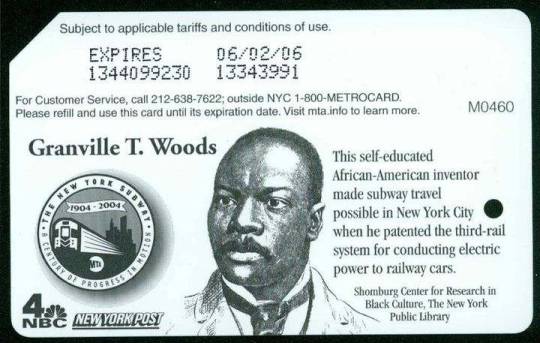
In 1904, Granville T Woods became one of the inventors of the NYC Subway System ~ New York City Transit Authority 🔥❤️💯
2 notes
·
View notes
Text
LIFE WITHOUT BLACK PEOPLE
(author unknown)
A very humorous and revealing story is told about a group of white people who were fed up with African Americans, so they joined together and wished themselves away. They passed through a deep dark tunnel and emerged in sort of a twilight zone where there is an America without Black people.
At first these white people breathed a sigh of relief. At last, they said, “No more crime, drugs, violence and welfare. All of the Black s have gone!”
Then suddenly, reality set in. The “NEW AMERICA” is not America at all — only a barren land.
1. There are very few crops that have flourished because the nation was built on a slave-supported system.
2. There are no cities with tall skyscrapers because Alexander Miles, a Black man, invented the elevator, and without it, one finds great difficulty reaching higher floors.
3. There are few if any cars because Richard Spikes, a Black man, invented the automatic gearshift, Joseph Gambol, also Black, invented the Super Charge System for Internal Combustion Engines, and Garrett A. Morgan, a Black man, invented the traffic signals.
4. Furthermore, one could not use the rapid transit system because its procurer was the electric trolley, which was invented by another Black man, Albert R. Robinson.
5. Even if there were streets on which cars and a rapid transit system could operate, they were cluttered with paper because an African American, Charles Brooks, invented the street sweeper.
6. There were few if any newspapers, magazines and books because John Love invented the pencil sharpener, William Purveys invented the fountain pen, and Lee Barrage invented the Type Writing Machine and W. A. Love invented the Advanced Printing Press. They were all, you guessed it, Black.
7. Even if Americans could write their letters, articles and books, they would not have been transported by mail because William Barry invented the Postmarking and Canceling Machine, William Purveys invented the Hand Stamp and Philip Downing invented the Letter Drop.
8. The lawns were brown and wilted because Joseph Smith invented the Lawn Sprinkler and John Burr the Lawn Mower.
9. When they entered their homes, they found them to be poorly ventilated and poorly heated. You see, Frederick Jones invented the Air Conditioner and Alice Parker the Heating Furnace. Their homes were also dim. But of course, Lewis Later invented the Electric Lamp, Michael Harvey invented the lantern and Granville T. Woods invented the Automatic Cut off Switch. Their homes were also filthy because Thomas W. Steward invented the Mop and Lloyd P. Ray the Dust Pan.
10. Their children met them at the door -- barefooted, shabby, motley and unkempt. But what could one expect? Jan E. Matzelinger invented the Shoe Lasting Machine, Walter Sammons invented the Comb, Sarah Boone invented the Ironing Board and George T. Samon invented the Clothes Dryer.
11. Finally, they were resigned to at least have dinner amidst all of this turmoil. But here again, the food had spoiled because another Black Man, John Standard invented the refrigerator.
Now, isn’t that something? What would this country be like without the contributions of Blacks, as African Americans?
Martin Luther King, Jr. said, “by the time we leave for work, Americans have depended on the inventions from the minds of Blacks.” Black history includes more than just slavery, Frederick Douglass, Martin Luther King, Jr., Malcolm X, and Marcus Garvey and W.E.B. Dubois.
#african american#america#racism#black history#inventions#contributions#bigotry#human rights#social justice#history
5 notes
·
View notes
Photo

5 Notable Black Inventors
1. Madam CJ. Walker
Born in 1867 and died in 1919. After suffering hair loss of her own from a scalp disorder she began working on the development of hair care products for African Americans.
2. Elijah McCoy
Born in 1843 and died in 1929. This noted African American inventor was issued more than 57 patents for his inventions during his lifetime. His best known invention was a cup that fed lubricating oil to machine bearings through a small bore tube. Machinists and engineers who wanted genuine McCoy lubricators used the expression “the real McCoy.”
3. Garrett A. Morgan
Born in 1887 and died in 1963. He developed both the first traffic signal invention and the first patented gas mask.
4. Granville T. Woods
Born in 1856 and died in 1910. Granville is known to many as “The Black Edison,” because both were great inventors who came from disadvantaged childhoods. But unlike Edison, Woods was considered fortunate to receive an education to help him on the road to his inventions. He invented the telegraphony. The telegraphony combined features of both the telephone and telegraph and was purchased by Alexander Graham Bell’s company. He later fought with Thomas Edison over patents for the telegraph.
5. Jan Ernst Matzeliger
Born in 1852 died in 1889. Jan invented a shoemaking machine that increased shoemaking speed by 900%! This allowed for lower prices for consumers and more jobs for workers. Matzeliger left behind a legacy of tackling what was thought to be an impossible task – making shoes affordable for the masses.
2 notes
·
View notes
Text
Source: Liberty Writers Global
#Granville T Woods#black inventor#roller coasters#multiplex telegraph#air brakes systems#black history#read about him#knowledge is power
10 notes
·
View notes
Photo
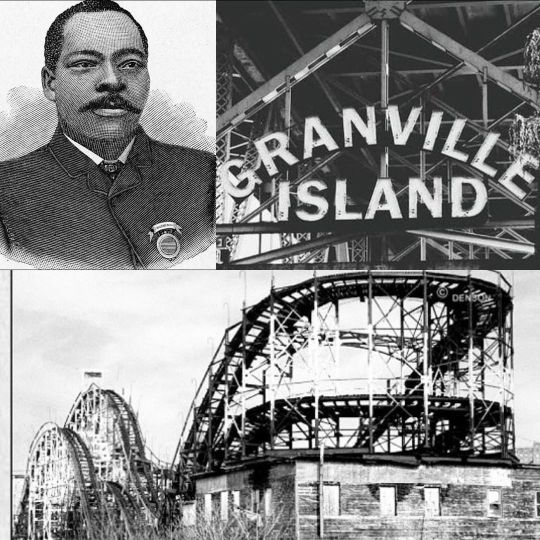
Before there was a Sesame Street or Place, there was, Coney Island and Granville Island! Granville T. Woods Known as the “Black Thomas Edison.” was an engineer who invented and patented an early electric the roller coaster, which he introduced in the summer of 1909 at Coney Island. He developed dozens of innovative mass transit improvements. Edison sued Woods charging that he (Edison) was the first to invent the multiplex telegraph. After a costly court battle, Woods won the case. But even after losing to Woods, Edison remained so impressed with him that he offered the Black genius a partnership in one of his companies Woods was inducted into the Coney Island Hall of Fame, and an adjacent street was renamed Granville T. Woods Way. https://www.instagram.com/p/CgNYxhYpdaP/?igshid=NGJjMDIxMWI=
6 notes
·
View notes
Text
Greetings everyone were celebrating black history month
electric trains? where did it all start?
check out this SHORT to find out
https://blackfacts.com/news/article/granville-t-woods-prominent-inventor-who-challenged-edisons-claim-to-the-multiplex-telegraph-in-court-and-won
0 notes
Text
Life Without Black People
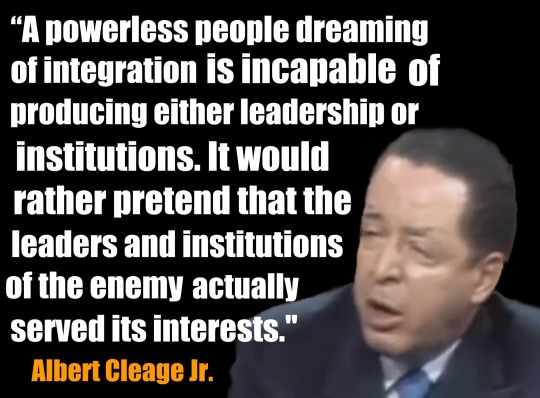
A very humorous and revealing story is told about a group of white people who were fed up with African Americans, so they joined together and wished themselves away. They passed through a deep dark tunnel and emerged in sort of a twilight zone where there is an America without black people.
At first these white people breathed a sigh of relief.
'At last', they said, 'no more crime, drugs, violence and welfare.'
All of the blacks have gone! Then suddenly, reality set in. The 'NEW AMERICA' is not America at all - only a barren land.
1. There are very few crops that have flourished because the nation was built on a slave-supported system.
2. There are no cities with tall skyscrapers because Alexander Mils, a black man, invented the elevator, and without it, one finds great difficulty reaching higher floors.
3. There are few if any cars because Richard Spikes, a black man, invented the automatic gearshift, Joseph Gambol, also black, invented the Super Charge System for Internal Combustion Engines, and Garrett A. Morgan, a black man,
invented the traffic signals.
4. Furthermore, one could not use the rapid transit system because its procurer was the electric trolley, which was invented by another black man, Albert R. Robinson.
5. Even if there were streets on which cars and a rapid transit system could operate, they were cluttered with paper because an African American, Charles Brooks, invented the street sweeper..
6. There were few if any newspapers, magazines and books because John Love invented the pencil sharpener, William Purveys invented the fountain pen, and Lee Barrage invented the Type Writing Machine and W. A. Love invented the Advanced Printing Press. They were all, you guessed it, Black.
7. Even if Americans could write their letters, articles and books, they would not have been transported by mail because William Barry invented the Postmarking and Canceling Machine, William Purveys invented the Hand Stamp and Philip Downing invented the Letter Drop.
8. The lawns were brown and wilted because Joseph Smith invented the Lawn Sprinkler and John Burr the Lawn Mower.
9. When they entered their homes, they found them to be poorly ventilated and poorly heated. You see, Frederick Jones invented the Air Conditioner and Alice Parker the Heating Furnace. Their homes were also dim. But of course, Lewis Lattimer later invented the Electric Lamp, Michael Harvey invented the lantern, and Granville T. Woods invented the Automatic Cut off Switch. Their homes were also filthy because Thomas W. Steward invented the Mop and Lloyd P. Ray the Dust Pan.
10. Their children met them at the door - barefooted, shabby, motley and unkempt. But what could one expect? Jan E. Matzelinger invented the Shoe Lasting Machine, Walter Sammons invented the Comb, Sarah Boone invented the Ironing Board, and George T. Samon invented the Clothes Dryer.
11. Finally, they were resigned to at least have dinner amidst all of this turmoil. But here again, the food had spoiled because another Black Man, John Standard invented the refrigerator...
Now, isn't that something? What would this country be like without the contributions of Blacks, as African-Americans?
Martin Luther King, Jr. said, 'by the time we leave for work, millions of Americans have depended on the inventions from the minds of Blacks.'
Black history includes more than just slavery, Frederick Douglas, Martin Luther Kinbg, Jr., Malcolm X, and Marcus Garvey & W.E.B. Dubois.
PLEASE SHARE, ABUNDANTLY
52 notes
·
View notes